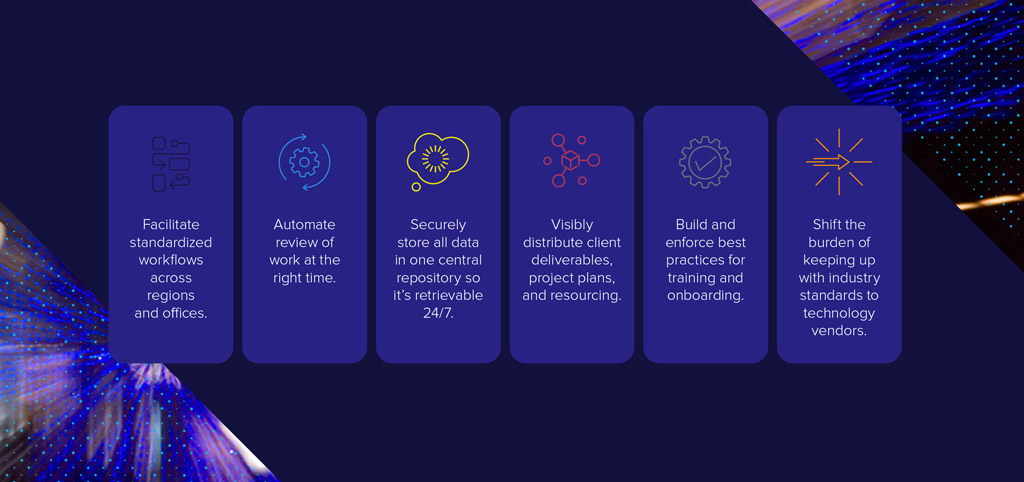Blog
6 Ways CMT Software Can Empower Your Team


Consider how much dialog can be lost over time through phone conversations, emails, and text messages. When you have a CMT software that digitally connects your workflows, there is much more opportunity for communication and collaboration, while mining historical dialog throughout the process.
Communication is truly the key to reducing risk. How can you make your employees feel more empowered in what they do on a daily basis? Below are six ways digitally connected workflows foster a positive and productive employee and client community.
Standardizing workflows is the key to the greatest experience for professionals and clients. It has a direct impact on brand recognition both internally and externally. Consider the saying, “you’re only as strong as your weakest link,” and how this can apply towards products and services a brand may produce. As you unify disparate offices or expand operations, you can confidently unite the workforce by providing the same product or services across the brand. Staff members have little to no acclimation periods towards operations and, client expectations can be met with consistency towards overall satisfaction and reliability.
Mergers and acquisition (M&A) activity is prevalent in this industry, along with growth and expansion. It’s much easier to expand and forecast operational needs and costs when you’re all using the same systems and processes. If you have systems in place that you’re adopting across your organization, onboarding new companies, staff, and delivering products becomes much easier. You’ll decrease overall time to value of new assets by accurately forecasting when you’re using a common ecosystem of tools.
A true digital solution should present items in need of your attention at the time they need to be reviewed as opposed to passively checking an inbox or relying on a manual hand off. There may be times when you’re reviewing a project dashboard and it’s critical to elevate certain items that need your immediate attention. You may also need alerts and flexibility to review on the go, without risk of becoming a bottleneck in overall turnaround time. The amount of cognitive load that you’re placing in your work gets reduced because digital systems allow you to focus on the priority items that need to be focused on at the appropriate time, while providing the flexibility to be untethered to a desk, network, or specific device.
The number of tools, systems, and platforms that are leveraged in daily activity can usually indicate a disjointed work environment that’s often tied to a fixed workload capacity. If someone were to ask you how data is stored for current and completed work and you describe a process instead of a simple answer, this might be an indication that a source of truth or seamless workflow has
yet to be established. The same might apply if various business lines or departments within operations have different answers towards data storage.
Consider how easy or difficult it is to find information. Do you know where to look for project site plans, testing information, samples, or equipment information? Consolidate your business tools and areas where data is stored and maintained, especially when the sheer number of different tools might be costing you something that’s negatively impacting your bottom line. All tools have a cost and it’s important to assess return on value, especially considering with how fast technology can change.
Long are the days where we send something in the mail and clients receive it. Today, nearly all business deliverables are sent via email with PDF attachments, digital uploads, client portals, and file sharing. That is certainly a step in the right direction when it comes to accessing data at your fingertips, but it’s time to take things a step farther.
Technology can advance visibility and teamwork by sending deliverables and data digitally and tracking the footprint. You then have insight to when items are delivered and how long people are spending consuming those documents. The responses can be stored in one repository as opposed to individual email boxes. If you can track consumption of deliverables, consider other data points throughout the lifecycle of projects that might be beneficial to relay to clients, such as change orders, changes in schedules, contractor information, and more. Again, think about how to consolidate and use tools smarter to your advantage that can push the business and client relationship more towards partnership.
Onboarding is often seen as the backbone of a company, especially in a market where we’re experiencing a war for talent. Standardized workflows can play a critical role in providing a quality onboarding experience and reducing that individual’s time to value at the onset of a new job. Typically, the first four or five weeks of new hires are the most difficult because the new employees are trying to acclimate themselves and gain familiarity with process and people. Think about what you can do as a company to make sure their time to value is minimized while providing a
platform to be successful. Technology can streamline training, information, and unite a workforce of people. Organizations that can optimize the entire onboarding experience often tend to be the most successful in attracting and retaining talent. Remember, profitability is measured on more than just dollars and cents. It’s worth asking how technology can reduce the time to onboard
so their time to value is minimized.
There’s also something to be said about the feeling of value. When there’s value involved, there’s an emotional connection towards satisfaction, joy, and purpose. When you have a new employee, consider what you can do with technology to ensure they’re not isolated and have an early opportunity to add or contribute value. If they make mistakes, modern systems might prevent something from being amplified because you can catch them ahead of time or enforce proper training and safety measures. Leverage technology to provide that safe environment
to make mistakes, and support not only new employees but everyone, to fall forward instead of backward. Think about training and support towards decreasing time to an emotional connection of value that makes part of your brand experience personal. This will certainly lead to multiple avenues of profitability.
If you’re working with providers and vendors, remember they have a community to support. Technology vendors strive to ensure they’re providing the appropriate industry standard forms from a compliance standpoint. Vendors can do that more efficiently and push that across their customer base at once versus putting that burden upon individual firms. As standards are revised, it’s critical to work with forms that are up to date. If you’re using Excel, how are you ensuring all documents are maintained and updated according to industry standards? Working with
the right vendor partner will ensure you are operating according to industry compliance.
Learn how cmt software can not only help empower your team, but also help you become more profitable, and drive additional value to your clients in our new guide. In the guide we explore how technology can unlock growth through flexible and efficient workflows, and we include a BONUS worksheet to help you audit where your firm stands today.
